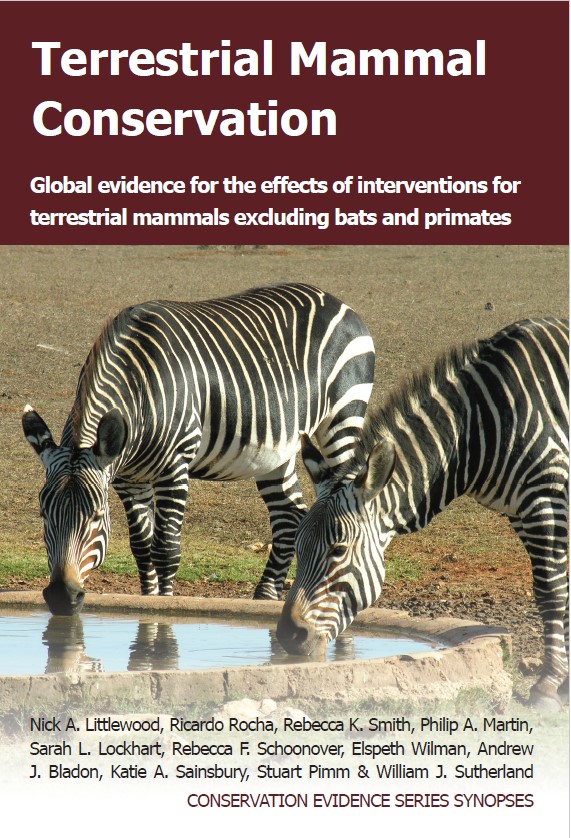Actions to conserve biodiversity
We have summarised evidence from the scientific literature about the effects of actions to conserve wildlife and ecosystems.
Review the evidence from the studies
Not sure what Actions are? Read a brief description.
Search for evidence
e.g. "frogs chytrid"
294 Actions found
Refine
Hide
294 Actions found
Download Actions
| 0 selected |
|
Order results by:
| Action | Effectiveness | Studies | Category | |
|---|---|---|---|---|
|
Control non-native prey species to reduce populations and impacts of non-native predators Action Link |
No evidence found (no assessment) | 0 |
|
|
|
Provide artificial refuges for prey to evade/escape non-native predators Action Link |
No evidence found (no assessment) | 0 |
|
|
|
Remove/control non-native species that could interbreed with native species Action Link |
No evidence found (no assessment) | 0 |
|
|
|
Modify traps used in the control/eradication of non-native species to avoid injury of non-target mammal Action Link |
Unknown effectiveness (limited evidence) | 1 |
|
|
|
Use conditioned taste aversion to prevent non-target species from entering traps Action Link |
Likely to be beneficial | 1 |
|
|
|
Use reward removal to prevent non-target species from entering traps Action Link |
Likely to be beneficial | 1 |
|
|
|
Reduce pesticide or fertilizer use Action Link |
Unknown effectiveness (limited evidence) | 3 |
|
|
|
Leave headlands in fields unsprayed Action Link |
Likely to be beneficial | 2 |
|
|
|
Establish riparian buffers Action Link |
No evidence found (no assessment) | 0 |
|
|
|
Translocate mammals away from site contaminated by oil spill Action Link |
Unknown effectiveness (limited evidence) | 1 |
|
|
|
Remove topsoil that has had fertilizer added to mimic low nutrient soil Action Link |
No evidence found (no assessment) | 0 |
|
|
|
Manage vegetation using livestock grazing Action Link |
Likely to be beneficial | 6 |
|
|
|
Install pole crossings for gliders/flying squirrels Action Link |
Likely to be beneficial | 7 |
|
|
|
Manage vegetation using grazing by wild herbivores Action Link |
Unknown effectiveness (limited evidence) | 2 |
|
|
|
Replant vegetation Action Link |
No evidence found (no assessment) | 0 |
|
|
|
Remove vegetation by hand/machine Action Link |
Likely to be beneficial | 20 |
|
|
|
Retain/provide migration corridors Action Link |
No evidence found (no assessment) | 0 |
|
|
|
Protect habitat along elevational gradients Action Link |
No evidence found (no assessment) | 0 |
|
|
|
Translocate animals from source populations subject to similar climatic conditions Action Link |
Unknown effectiveness (limited evidence) | 1 |
|
|
|
Provide dams/water holes during drought Action Link |
No evidence found (no assessment) | 0 |
|
|
|
Apply water to vegetation to increase food availability during drought Action Link |
Unknown effectiveness (limited evidence) | 1 |
|
|
|
Install rope bridges between canopies Action Link |
Beneficial | 10 |
|
|
|
Remove flood water Action Link |
No evidence found (no assessment) | 0 |
|
|
|
Install one-way gates or other structures to allow wildlife to leave roadways Action Link |
Likely to be beneficial | 7 |
|
|
|
Legally protect habitat for mammals Action Link |
Beneficial | 7 |
|
Download Actions
| 0 selected |
|

Terrestrial Mammal Conservation - Published 2020
Terrestrial Mammal Conservation
Watch this search
If you are familiar with RSS feeds, please click the button below to retrieve the feed URL:
RSS feed for this searchIf you are unfamiliar with RSS feeds, we would suggest reading this BBC article.
Unfortunately, due to the number of feeds we have available, we cannot provide e-mail updates. However, you could use tools such as Feed My Inbox to do this for you.
What are 'Individual studies' and 'Actions'?
Individual studies
An individual study is a summary of a specific scientific study, usually taken from a scientific journal, but also from other resources such as reports. It tells you the background context, the action(s) taken and their consequences.
If you want more detail please look at the original reference.
Actions
Each action page focuses on a particular action you could take to benefit wildlife or ecosystems.
It contains brief (150-200 word) descriptions of relevant studies (context, action(s) taken and their consequences) and one or more key messages.
Key messages show the extent and main conclusions of the available evidence. Using links within key messages, you can look at the paragraphs describing each study to get more detail. Each paragraph allows you to assess the quality of the evidence and how relevant it is to your situation.
Where we found no evidence, we have been unable to assess whether or not an intervention is effective or has any harmful impacts.





)_2023.JPG)














